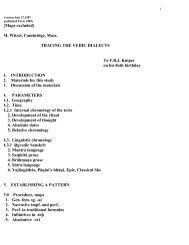references - people.fas.harvard.edu - Harvard University
references - people.fas.harvard.edu - Harvard University
references - people.fas.harvard.edu - Harvard University
Create successful ePaper yourself
Turn your PDF publications into a flip-book with our unique Google optimized e-Paper software.
Paul-André Bempéchat has been an Affi liate at <strong>Harvard</strong>’s Center for European Studies since 2002. Trained at<br />
The Juilliard School and at the Sorbonne and Boston <strong>University</strong> in musicology and comparative literature, he is the fi rst biographer of<br />
the Breton impressionist Jean Cras (Ashgate, 2009), and an internationally renowned concert pianist.<br />
ABSTRACT<br />
Felix Mendelssohn’s “Reformation” Symphony, opus 107 (1829-30) – “the beast,” according to his sister Fanny<br />
– remains, along with his oratorios Saint Paul (1836) and Elijah (1846), one of his most controversial works.<br />
The symphony, composed in competition with works by other composers, was intended not only to honor the<br />
tercentenary of the Augsburg Confession, the principle doctrine of the Lutheran faith, but to convince Germans<br />
that one of their nation’s most prominent Jewish families, recent converts to Protestantism, had assimilated.<br />
Mendelssohn’s supreme efforts, spiritual, psychological, and technical, proved fruitless, most likely due to his<br />
Jewish origins, and to the thematic ecumenism of his symphony, which, projecting its author’s own reconciliation<br />
of these traditions, unites motives from the Christian and Jewish traditions. Mendelssohn’s religious<br />
convictions have, since the end of the Second World War, become an unnecessarily divisive source of controversy<br />
between musicologists and social historians. Aided by an analysis of Mendelssohn’s spiritual hybridity<br />
as expressed in the symphony, this essay will strive to resolve the controversy by elucidating the psychological<br />
intricacies of German Jewish conversion during the late eighteenth and early nineteenth century, and the futile<br />
drive by German Jews to assimilate into a society that would ultimately affi rm and reject them as outsiders.<br />
ces papers - open forum # 6, 2011<br />
1

















